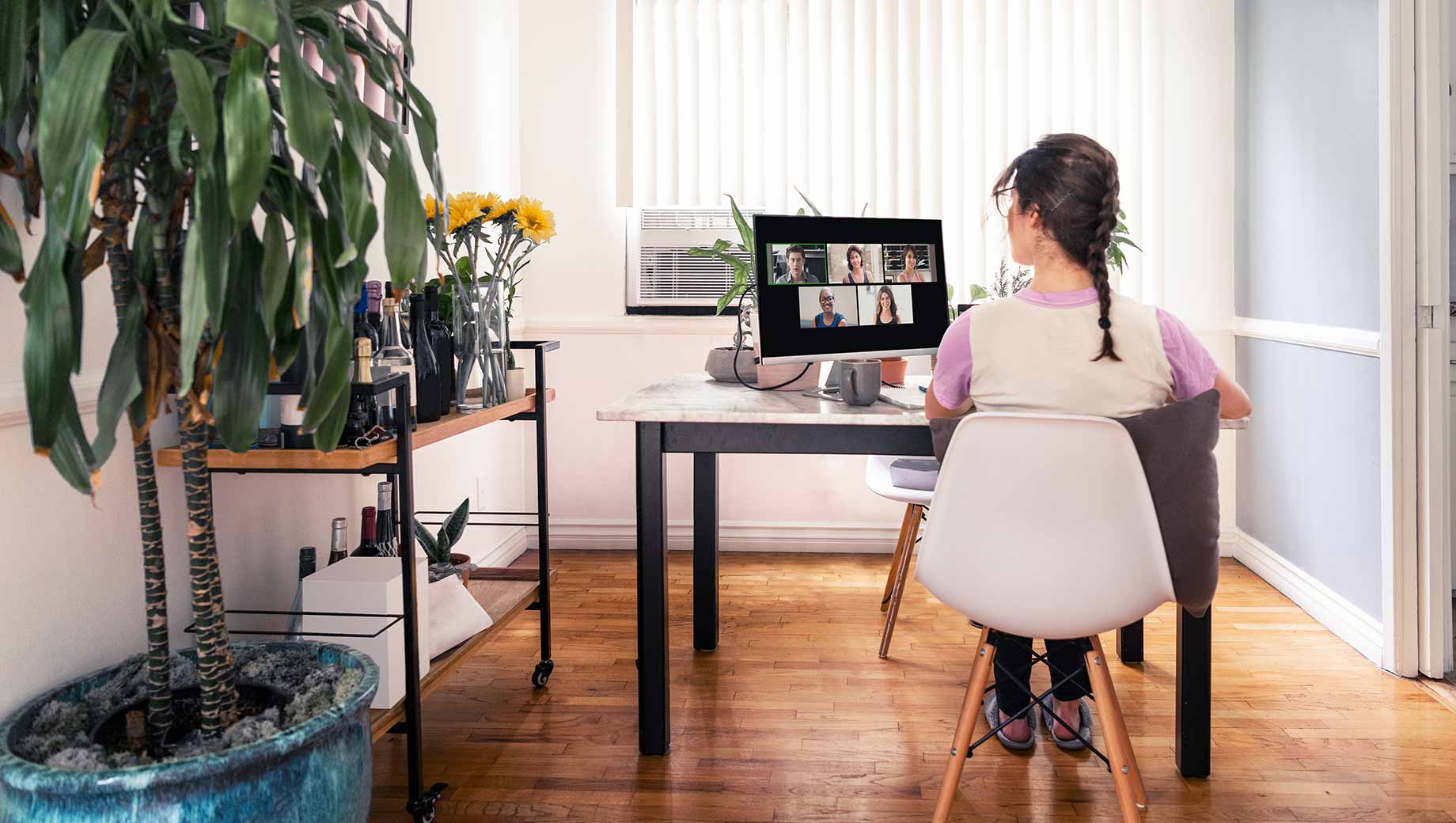Story Highlights
- Nearly as many working remotely in 2021 as was true for much of 2020
- Percentage working remotely exceeds 80% in some white-collar occupations
- Four in 10 white-collar workers prefer remote work
WASHINGTON, D.C. -- Before the Centers for Disease Control and Prevention (CDC) announcement last week that fully vaccinated people can forgo masks in most settings, the majority of U.S. workers reported doing their jobs remotely during the pandemic, including 51% in April. But this varied widely by job type, including 72% of white-collar workers and 14% of blue-collar workers. These rates have been fairly stable since last fall, after declining from their peaks in April 2020, when most schools and non-essential businesses were shuttered.

Line graph. Monthly trend from April 2020 to April 2021 in percentage of white-collar, blue-collar and all U.S. adults employed full-time for an employer who have worked from home at least 10% of the time. Rate for all workers was 69% in April 2020 before falling to 53% by July. It has since registered near the latter level, including 51% in April 2021. Rate for white-collar workers peaked at 83% in April 2020 and has since fallen to just over 70%. Rate for blue-collar workers was 19% in April 2020 and has since been closer to 15%.
Gallup's remote-worker trend is based on data collected each month via web as part of its COVID-19 tracking poll, a nationally representative survey of U.S. adults aged 18 and older, using the probability-based Gallup Panel. Workers are considered remote if they report working from home at least 10% of the time in the past week.
Given the relative stability of remote work over the second half of the pandemic to date -- from October 2020 to April 2021 -- it is appropriate to use the combined data to analyze aspects of remote work in greater detail. On average during this period, 52% of all workers, including 72% of those in white-collar occupations and 14% in blue-collar occupations, have performed their job all or part of the time from home.
Gallup's white-collar job category comprises occupations traditionally performed in offices or behind a computer. The blue-collar category includes jobs mainly involving manual work or physical labor. Three job areas -- education, healthcare and sales -- primarily involve interaction with clients or the public and are harder to categorize using the blue-collar/white-collar definitions. Their orientation to remote work is unique and is discussed below in the context of other specific occupations.
For more information on the percentage of time employees are working remotely and a discussion of how Gallup calculates the metric, see the research note at the end of this article.
Remote Work Rates Exceed 80% in Some Occupations
The combined dataset also affords sufficient sample sizes to report the remote-work patterns among workers in 16 occupations or types of work, as well as by gender within select job categories.
On average, from October 2020 to April 2021, at least eight in 10 workers in four occupation categories have been working remotely, including:
- computer-oriented or mathematical fields (86%)
- the life, physical or social sciences (86%)
- the arts, design, entertainment or media (81%)
- financial services, insurance, real estate or consulting (80%)
Not only do large proportions of workers in these occupations report working remotely at least some of the time, but majorities say they are doing so exclusively.
Other occupational groups reporting high remote-work rates include the legal field (74%), education, training or library work (69%), architecture/engineering (67%), workers in community or social services (60%), and clerical or office workers (56%).
From there, it's a steep drop to 36% of those working remotely in sales and 33% in healthcare. The rate falls further to relatively small percentages in manual labor or service-oriented fields. This includes 16% in construction or mining; 15% in installation, maintenance or repair; 14% in transportation; 9% of service workers; and 8% in manufacturing or production.
| Total working remotely |
Exclusively (100%) |
Sometimes (10%-99%) |
Never/Rarely (less than 10%) |
|||||||||||||||||||||||||||||||||||||||||||||||||||||||||||||||||||||||||||||||||||||||||||||||||
|---|---|---|---|---|---|---|---|---|---|---|---|---|---|---|---|---|---|---|---|---|---|---|---|---|---|---|---|---|---|---|---|---|---|---|---|---|---|---|---|---|---|---|---|---|---|---|---|---|---|---|---|---|---|---|---|---|---|---|---|---|---|---|---|---|---|---|---|---|---|---|---|---|---|---|---|---|---|---|---|---|---|---|---|---|---|---|---|---|---|---|---|---|---|---|---|---|---|---|---|---|
| % | % | % | % | |||||||||||||||||||||||||||||||||||||||||||||||||||||||||||||||||||||||||||||||||||||||||||||||||
| Total | 52 | 33 | 19 | 48 | ||||||||||||||||||||||||||||||||||||||||||||||||||||||||||||||||||||||||||||||||||||||||||||||||
| Majority working from home | ||||||||||||||||||||||||||||||||||||||||||||||||||||||||||||||||||||||||||||||||||||||||||||||||||||
| Computer, Mathematical | 86 | 73 | 13 | 14 | ||||||||||||||||||||||||||||||||||||||||||||||||||||||||||||||||||||||||||||||||||||||||||||||||
| Life, Physical or Social sciences | 86 | 51 | 35 | 14 | ||||||||||||||||||||||||||||||||||||||||||||||||||||||||||||||||||||||||||||||||||||||||||||||||
| Arts, Design, Entertainment, Media | 81 | 64 | 17 | 18 | ||||||||||||||||||||||||||||||||||||||||||||||||||||||||||||||||||||||||||||||||||||||||||||||||
| Financial, Insurance, Real estate, Consulting | 80 | 66 | 14 | 20 | ||||||||||||||||||||||||||||||||||||||||||||||||||||||||||||||||||||||||||||||||||||||||||||||||
| Legal | 74 | 46 | 28 | 27 | ||||||||||||||||||||||||||||||||||||||||||||||||||||||||||||||||||||||||||||||||||||||||||||||||
| Education, Training, Library | 69 | 37 | 32 | 31 | ||||||||||||||||||||||||||||||||||||||||||||||||||||||||||||||||||||||||||||||||||||||||||||||||
| Architecture, Engineering | 67 | 32 | 35 | 33 | ||||||||||||||||||||||||||||||||||||||||||||||||||||||||||||||||||||||||||||||||||||||||||||||||
| Community or Social services | 60 | 27 | 33 | 39 | ||||||||||||||||||||||||||||||||||||||||||||||||||||||||||||||||||||||||||||||||||||||||||||||||
| Clerical or Office | 56 | 37 | 19 | 44 | ||||||||||||||||||||||||||||||||||||||||||||||||||||||||||||||||||||||||||||||||||||||||||||||||
| Less than majority working from home | ||||||||||||||||||||||||||||||||||||||||||||||||||||||||||||||||||||||||||||||||||||||||||||||||||||
| Sales | 36 | 20 | 16 | 64 | ||||||||||||||||||||||||||||||||||||||||||||||||||||||||||||||||||||||||||||||||||||||||||||||||
| Healthcare | 33 | 15 | 18 | 68 | ||||||||||||||||||||||||||||||||||||||||||||||||||||||||||||||||||||||||||||||||||||||||||||||||
| Construction, Mining | 16 | 8 | 8 | 84 | ||||||||||||||||||||||||||||||||||||||||||||||||||||||||||||||||||||||||||||||||||||||||||||||||
| Installation, Maintenance, Repair | 15 | 3 | 12 | 85 | ||||||||||||||||||||||||||||||||||||||||||||||||||||||||||||||||||||||||||||||||||||||||||||||||
| Transportation | 14 | 9 | 5 | 86 | ||||||||||||||||||||||||||||||||||||||||||||||||||||||||||||||||||||||||||||||||||||||||||||||||
| Service | 9 | 3 | 6 | 91 | ||||||||||||||||||||||||||||||||||||||||||||||||||||||||||||||||||||||||||||||||||||||||||||||||
| Manufacturing, Production | 8 | 4 | 4 | 92 | ||||||||||||||||||||||||||||||||||||||||||||||||||||||||||||||||||||||||||||||||||||||||||||||||
| Based on full-time employees who work for an employer; industries with fewer than 130 respondents not reported due to low sample size. "Total" figures may not match the sum of "Exclusively" and "Sometimes" responses due to rounding. | ||||||||||||||||||||||||||||||||||||||||||||||||||||||||||||||||||||||||||||||||||||||||||||||||||||
| Gallup Panel, October 2020-April 2021 | ||||||||||||||||||||||||||||||||||||||||||||||||||||||||||||||||||||||||||||||||||||||||||||||||||||
Desire to Stay Remote Varies Widely by Job
Gallup also asks employees who are working remotely at least some of the time to state their preferred work arrangement, once restrictions are lifted and assuming their employer leaves it up to them.
Thirty-five percent of all full-time employees say that, if given the choice, they would continue working remotely as much as possible. At the same time, 17% would opt to go back to the office, while the remaining 48% are not working remotely.
The 35% who would continue working remotely can be broken down further by workers' reasons for wanting to retain their remote status. Nine percent, on average since October, have said they want to maintain their remote status as much as possible because of concern about the coronavirus. The most recent data, from March (5%) and April (5%), show that the percentage in this category has dwindled as vaccinations have increased and infections have declined. Once those concerns are alleviated, many of these may be willing to return to an office or other workplace.
The other 26% want to continue working from home as much as possible because they prefer it. This group could prove the most resistant to employer requirements to return full-time, but they may be amenable to hybrid options that require some on-site work.
Looking at remote-work preferences among occupations with a large percentage of employees working from home reveals wide-ranging levels of desire to continue working remotely as a matter of personal preference. These include:
-
more than half of workers in the computer or mathematical occupations (54%)
-
just under half (45%) of those working in the arts/design/entertainment/media as well as the life/physical/social sciences
-
about four in 10 in the financial/insurance/real estate/consulting (41%) and legal (38%) fields
-
about a third in architecture/engineering (33%), clerical or other office workers (32%), and community or social services (31%)
-
closer to one in five workers in education/training/library (20%), sales (20%) and healthcare (18%)
When factoring in those who choose to continue working from home as much as possible because of concerns about the coronavirus, the total currently wanting to maintain their remote-work status exceeds 50% for several occupations.
| Would continue to work remotely because prefer it |
Would continue to work remotely because of coronavirus |
Would return to working in office |
Not working remotely now |
||||||||||||||||||||||||||||||||||||||||||||||||||||||||||||||||||||||||||||||||||||||||||||||||
|---|---|---|---|---|---|---|---|---|---|---|---|---|---|---|---|---|---|---|---|---|---|---|---|---|---|---|---|---|---|---|---|---|---|---|---|---|---|---|---|---|---|---|---|---|---|---|---|---|---|---|---|---|---|---|---|---|---|---|---|---|---|---|---|---|---|---|---|---|---|---|---|---|---|---|---|---|---|---|---|---|---|---|---|---|---|---|---|---|---|---|---|---|---|---|---|---|---|---|---|
| % | % | % | % | ||||||||||||||||||||||||||||||||||||||||||||||||||||||||||||||||||||||||||||||||||||||||||||||||
| Total | 26 | 9 | 17 | 48 | |||||||||||||||||||||||||||||||||||||||||||||||||||||||||||||||||||||||||||||||||||||||||||||||
| Computer, Mathematical | 54 | 11 | 21 | 14 | |||||||||||||||||||||||||||||||||||||||||||||||||||||||||||||||||||||||||||||||||||||||||||||||
| Arts, Design, Entertainment, Media | 45 | 16 | 21 | 18 | |||||||||||||||||||||||||||||||||||||||||||||||||||||||||||||||||||||||||||||||||||||||||||||||
| Life, Physical or Social sciences | 45 | 10 | 30 | 14 | |||||||||||||||||||||||||||||||||||||||||||||||||||||||||||||||||||||||||||||||||||||||||||||||
| Financial, Insurance, Real estate, Consulting | 41 | 15 | 24 | 20 | |||||||||||||||||||||||||||||||||||||||||||||||||||||||||||||||||||||||||||||||||||||||||||||||
| Legal | 38 | 14 | 21 | 27 | |||||||||||||||||||||||||||||||||||||||||||||||||||||||||||||||||||||||||||||||||||||||||||||||
| Architecture, Engineering | 33 | 7 | 28 | 33 | |||||||||||||||||||||||||||||||||||||||||||||||||||||||||||||||||||||||||||||||||||||||||||||||
| Clerical or Office | 32 | 8 | 15 | 44 | |||||||||||||||||||||||||||||||||||||||||||||||||||||||||||||||||||||||||||||||||||||||||||||||
| Community or Social services | 31 | 12 | 17 | 39 | |||||||||||||||||||||||||||||||||||||||||||||||||||||||||||||||||||||||||||||||||||||||||||||||
| Education, Training, Library | 20 | 16 | 33 | 31 | |||||||||||||||||||||||||||||||||||||||||||||||||||||||||||||||||||||||||||||||||||||||||||||||
| Sales | 20 | 5 | 12 | 64 | |||||||||||||||||||||||||||||||||||||||||||||||||||||||||||||||||||||||||||||||||||||||||||||||
| Healthcare | 18 | 6 | 9 | 68 | |||||||||||||||||||||||||||||||||||||||||||||||||||||||||||||||||||||||||||||||||||||||||||||||
| Based on full-time employees who work for an employer | |||||||||||||||||||||||||||||||||||||||||||||||||||||||||||||||||||||||||||||||||||||||||||||||||||
| Gallup Panel, October 2020-April 2021 | |||||||||||||||||||||||||||||||||||||||||||||||||||||||||||||||||||||||||||||||||||||||||||||||||||
White-Collar Men and Women Have Similar Views on Maintaining Remote Work
From October 2020 to April 2021, there is virtually no difference by gender in white-collar employees' preferences for returning to work. Roughly four in 10 white-collar men (41%) and white-collar women (39%) say that, if given a choice, they would continue working remotely as much as possible because they prefer it. Another 10% of white-collar men and 12% of white-collar women say they would stay remote, citing concerns about the coronavirus.
At the same time, there is a distinct gender gap in remote-work preferences among blue-collar, education, healthcare and sales workers, with women more likely than men in these fields to want to maintain their remote status. Additionally, sizable percentages of men (16%) and women (15%) working in education want to continue working remotely because of concerns about the coronavirus -- a view that is less prevalent among healthcare and sales workers of either gender.
Notably, women constitute the large majority of full-time employees in education and healthcare, and thus, their preferences will have a much greater effect on the future of work in these fields than in blue-collar industries, where only 12% of workers are women, according to the Gallup data. White-collar workers include about equal proportions of men and women.
| Would continue to work remotely because prefer it |
Would continue to work remotely because of coronavirus |
Would return to working in office |
Not working remotely now |
|||||||||||||||||||||||||||||||||||||||||||||||||||||||||||||||||||||||||||||||||||||||||||||||||
|---|---|---|---|---|---|---|---|---|---|---|---|---|---|---|---|---|---|---|---|---|---|---|---|---|---|---|---|---|---|---|---|---|---|---|---|---|---|---|---|---|---|---|---|---|---|---|---|---|---|---|---|---|---|---|---|---|---|---|---|---|---|---|---|---|---|---|---|---|---|---|---|---|---|---|---|---|---|---|---|---|---|---|---|---|---|---|---|---|---|---|---|---|---|---|---|---|---|---|---|---|
| % | % | % | % | |||||||||||||||||||||||||||||||||||||||||||||||||||||||||||||||||||||||||||||||||||||||||||||||||
| White collar | ||||||||||||||||||||||||||||||||||||||||||||||||||||||||||||||||||||||||||||||||||||||||||||||||||||
| Total | 40 | 11 | 21 | 29 | ||||||||||||||||||||||||||||||||||||||||||||||||||||||||||||||||||||||||||||||||||||||||||||||||
| Men | 41 | 10 | 25 | 25 | ||||||||||||||||||||||||||||||||||||||||||||||||||||||||||||||||||||||||||||||||||||||||||||||||
| Women | 39 | 12 | 17 | 32 | ||||||||||||||||||||||||||||||||||||||||||||||||||||||||||||||||||||||||||||||||||||||||||||||||
| Blue collar | ||||||||||||||||||||||||||||||||||||||||||||||||||||||||||||||||||||||||||||||||||||||||||||||||||||
| Total | 7 | 2 | 6 | 86 | ||||||||||||||||||||||||||||||||||||||||||||||||||||||||||||||||||||||||||||||||||||||||||||||||
| Men | 5 | 2 | 6 | 86 | ||||||||||||||||||||||||||||||||||||||||||||||||||||||||||||||||||||||||||||||||||||||||||||||||
| Women | 15 | 1 | 4 | 80 | ||||||||||||||||||||||||||||||||||||||||||||||||||||||||||||||||||||||||||||||||||||||||||||||||
| Education | ||||||||||||||||||||||||||||||||||||||||||||||||||||||||||||||||||||||||||||||||||||||||||||||||||||
| Total | 19 | 15 | 32 | 33 | ||||||||||||||||||||||||||||||||||||||||||||||||||||||||||||||||||||||||||||||||||||||||||||||||
| Men | 15 | 16 | 40 | 28 | ||||||||||||||||||||||||||||||||||||||||||||||||||||||||||||||||||||||||||||||||||||||||||||||||
| Women | 21 | 15 | 29 | 36 | ||||||||||||||||||||||||||||||||||||||||||||||||||||||||||||||||||||||||||||||||||||||||||||||||
| Healthcare | ||||||||||||||||||||||||||||||||||||||||||||||||||||||||||||||||||||||||||||||||||||||||||||||||||||
| Total | 17 | 6 | 9 | 68 | ||||||||||||||||||||||||||||||||||||||||||||||||||||||||||||||||||||||||||||||||||||||||||||||||
| Men | 8 | 3 | 13 | 76 | ||||||||||||||||||||||||||||||||||||||||||||||||||||||||||||||||||||||||||||||||||||||||||||||||
| Women | 21 | 7 | 7 | 65 | ||||||||||||||||||||||||||||||||||||||||||||||||||||||||||||||||||||||||||||||||||||||||||||||||
| Sales | ||||||||||||||||||||||||||||||||||||||||||||||||||||||||||||||||||||||||||||||||||||||||||||||||||||
| Total | 26 | 7 | 14 | 53 | ||||||||||||||||||||||||||||||||||||||||||||||||||||||||||||||||||||||||||||||||||||||||||||||||
| Men | 21 | 5 | 13 | 60 | ||||||||||||||||||||||||||||||||||||||||||||||||||||||||||||||||||||||||||||||||||||||||||||||||
| Women | 33 | 11 | 16 | 40 | ||||||||||||||||||||||||||||||||||||||||||||||||||||||||||||||||||||||||||||||||||||||||||||||||
| Based on full-time employees who work for an employer | ||||||||||||||||||||||||||||||||||||||||||||||||||||||||||||||||||||||||||||||||||||||||||||||||||||
| Gallup Panel, October 2020-April 2021 | ||||||||||||||||||||||||||||||||||||||||||||||||||||||||||||||||||||||||||||||||||||||||||||||||||||
Bottom Line
Occupations consisting mainly of people who perform their jobs behind desks have experienced the remote-work revolution most intensely in the past year. More than seven in 10 workers in such "white collar" jobs have been working from home all or part of the time, in contrast with fewer than two in 10 blue-collar workers.
Reflecting this, a much higher percentage of white-collar than blue-collar workers want to continue working remotely. In recent months, 40% of all white-collar workers say they would like to continue working from home because they prefer it, and another 11% would opt to stay remote because of concerns about the coronavirus. In earlier months, more wanted to remain remote due to the coronavirus, but as that view has declined, many have shifted to saying they simply prefer remote work.
Workers in education also report high remote-work rates, averaging 69% since October, but just 19% -- far less than white-collar workers -- would prefer to maintain this going forward.
Of course, employers will have a say in how much remote work happens post-pandemic, with some companies already announcing that working from home will no longer be an option, once the health risks of returning to work are minimized. Other firms are offering hybrid solutions that will allow employees to work remotely part of the time but require some days spent in the office. The extent to which many employers allow employees to work remotely will likely be informed by how successfully an employee's specific role can be performed outside the workplace.
The new CDC guidelines, should they persist, will give added support to those arguing it's safe to bring workers back to offices, school buildings and other work sites. But remote employees' desire to continue working from home now has less to do with health safety and is more about their preference for being remote.
As leaders make important decisions about what happens next, the data suggest that hybrid approaches will be the much safer bet for companies hoping to retain and attract employees in fields where 70% or more of their workers have grown accustomed to working from home, and where a third or more are reluctant to give that up.
Research Note
The remote-work estimates reported here are based on a pair of questions asking all workers to specify how many hours they worked in the previous seven days, and then the number of hours they spent working from home. The percentage each employee works remotely is calculated by dividing their home-based hours by their total work hours. For this analysis, Gallup considers remote workers to be anyone working 10% or more of their time from home, and further divides that group into those working exclusively (100%) from home versus those sometimes working from home (10% to 99%).
This approach differs from a separate measure on the survey that asks employees whether they "always," "sometimes" or "never" work from home in order "to avoid catching or spreading the coronavirus." Gallup has previously reported the combined always/sometimes result as an indicator of the prevalence of remote work during the pandemic.
The two measures produce similar results, but for this analysis, the hours-based metric was used in order to exclude employees who only work minimal hours remotely.
As can be seen in the following table, the percentages working various proportions of their time from home have changed only slightly over the past year.
| Apr 2020-Sep 2020 | Oct 2020-Apr 2021 | Change | ||||||||||||||||||||||||||||||||||||||||||||||||||||||||||||||||||||||||||||||||||||||||||||||||||
|---|---|---|---|---|---|---|---|---|---|---|---|---|---|---|---|---|---|---|---|---|---|---|---|---|---|---|---|---|---|---|---|---|---|---|---|---|---|---|---|---|---|---|---|---|---|---|---|---|---|---|---|---|---|---|---|---|---|---|---|---|---|---|---|---|---|---|---|---|---|---|---|---|---|---|---|---|---|---|---|---|---|---|---|---|---|---|---|---|---|---|---|---|---|---|---|---|---|---|---|---|
| % | % | pct. pts. | ||||||||||||||||||||||||||||||||||||||||||||||||||||||||||||||||||||||||||||||||||||||||||||||||||
| Total work from home (10%-100%) | 56 | 52 | -4 | |||||||||||||||||||||||||||||||||||||||||||||||||||||||||||||||||||||||||||||||||||||||||||||||||
| Summary | ||||||||||||||||||||||||||||||||||||||||||||||||||||||||||||||||||||||||||||||||||||||||||||||||||||
| Exclusively (100%) | 38 | 33 | -5 | |||||||||||||||||||||||||||||||||||||||||||||||||||||||||||||||||||||||||||||||||||||||||||||||||
| Sometimes (10%-99%) | 18 | 19 | +1 | |||||||||||||||||||||||||||||||||||||||||||||||||||||||||||||||||||||||||||||||||||||||||||||||||
| Rarely/Never (0%-9%) | 44 | 48 | +4 | |||||||||||||||||||||||||||||||||||||||||||||||||||||||||||||||||||||||||||||||||||||||||||||||||
| Detailed results | ||||||||||||||||||||||||||||||||||||||||||||||||||||||||||||||||||||||||||||||||||||||||||||||||||||
| 100% | 38 | 33 | -5 | |||||||||||||||||||||||||||||||||||||||||||||||||||||||||||||||||||||||||||||||||||||||||||||||||
| 80% to 99% | 5 | 4 | -1 | |||||||||||||||||||||||||||||||||||||||||||||||||||||||||||||||||||||||||||||||||||||||||||||||||
| 60% to 79% | 3 | 3 | 0 | |||||||||||||||||||||||||||||||||||||||||||||||||||||||||||||||||||||||||||||||||||||||||||||||||
| 40% to 59% | 4 | 4 | 0 | |||||||||||||||||||||||||||||||||||||||||||||||||||||||||||||||||||||||||||||||||||||||||||||||||
| 10% to 39% | 6 | 8 | +2 | |||||||||||||||||||||||||||||||||||||||||||||||||||||||||||||||||||||||||||||||||||||||||||||||||
| 1% to 9% | 3 | 3 | 0 | |||||||||||||||||||||||||||||||||||||||||||||||||||||||||||||||||||||||||||||||||||||||||||||||||
| 0% | 41 | 45 | +4 | |||||||||||||||||||||||||||||||||||||||||||||||||||||||||||||||||||||||||||||||||||||||||||||||||
| Based on full-time employees who work for an employer | ||||||||||||||||||||||||||||||||||||||||||||||||||||||||||||||||||||||||||||||||||||||||||||||||||||
| Gallup Panel | ||||||||||||||||||||||||||||||||||||||||||||||||||||||||||||||||||||||||||||||||||||||||||||||||||||




